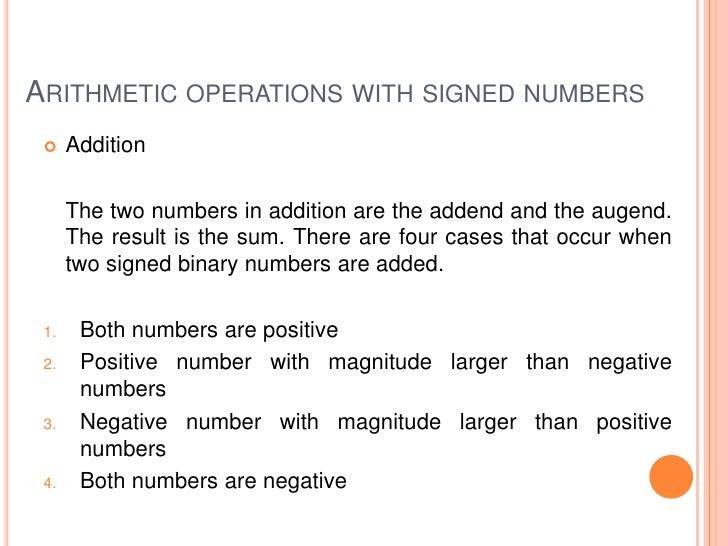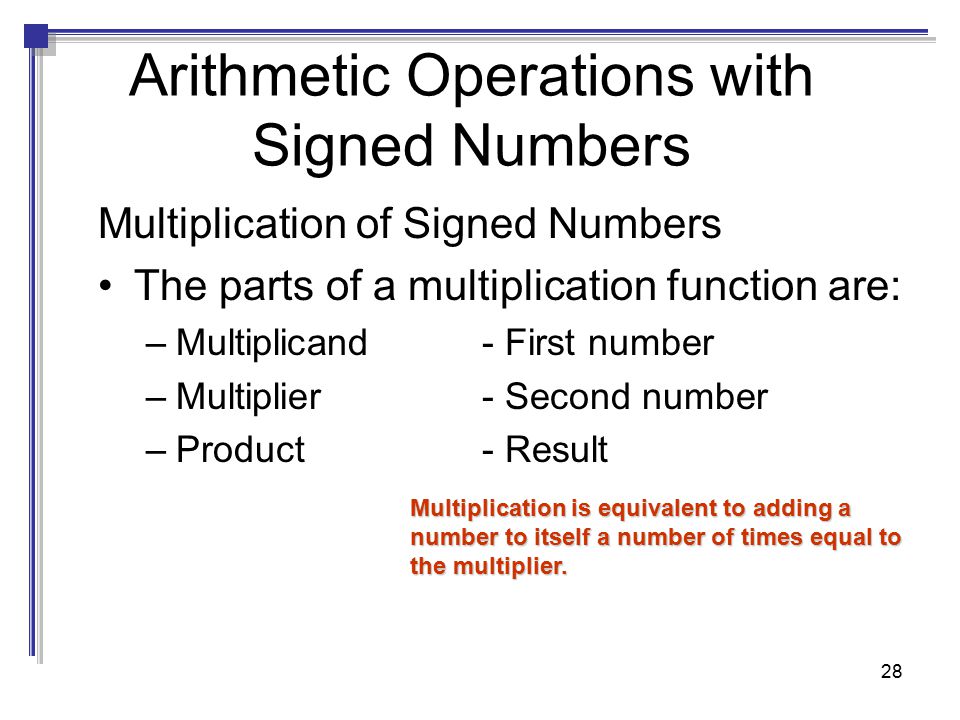Mathematical operations binary numbers
Basic mathematical operations with binary numbers works similar to the decimal system.
However there are a few rules specific to the binary system. There are 3 basic rules for adding binary numbers:. Other rules are same as the decimal system, i. Now lets try adding 11 to Binary for 11 is and that for 13 is The sum is Multiplication in binary is exactly as it is in decimal, i.
The 3 basic binary multiplication rules are also similar to decimal. Also, remember that for every left shift of digit of the multiplier, an extra zero needs to be appended to the product. This is similar to the decimal system as well.

Before trying subtraction, we need to understand how negative numbers are represented in binary. Whatever system is used i. There are 3 basic standards for notating negative numbers. In this notation, an extra bit is added to the left of the number to notate its sign. In this notation positive numbers are represented exactly as regular binary numbers. So 13 will be and 11 will be Negative numbers are represented simply by flipping the bit, i.
So will be and will be In this method the number being subtracted has to be negated using 1's complement and then added not subtracted to the other number. Adding these will result It has a 1 at the left indicating it as negative. Using 1's complement we can figure out the absolute positive number which is or 2. So the result is In this method a negative number is notated by first determining the 1's complement of the positive number and then adding mathematical operations binary numbers to it.
When adding or subtracting 2's complement binary numbers, any extra carry over bits are discarded. Now lets try the same examples we tried in 1's complement. A 1 at the left most bit signifies negative number.
Since this is in 2's complement, we subtract 1 from it to get the 1's complement notation of Flipping the bits we stockland rockhampton opening hours boxing day or 2, meaning our result is -2 in 2's complement notation.
While performing binary operations, it is important to know the convention being used in order to perform the operation following the applicable rules. Binary division is similar to decimal division. The only difference is that in decimal system, since we are option trading calculator traditional numbers, the dividend or portion of it can be 0, 1 or more than 1 times of the divisor.
However in binary, it can only be 0 or 1 times, i. Aksjer day trading of 6 is and that mathematical operations binary numbers 3 is Following decimal division convention. Since we have no more bits remaining in the dividend, we stop here and check.

Division can become more complicated with signed numbers, and floating point binary numbers not covered in this tutorial. Malay Biswas Blocked Unblock Follow Following Aug 27, Addition There are 3 basic rules for adding binary numbers: If the sum of 2 bits is greater than 1, we need to shift a column on the left. So we keep 0 in the 1's column and shift carry over 1 to the 2's column.
We keep 0 in 1's col and carry over 1 to 2's col. Once again we keep 0 in 2's col and carry over 1 to 4's col.
A tutorial on binary numbers
Keep 0 in 4's col and carry over 1 in 8's col. Keep 1 in 8's col and carry over 1 in 16's col. Multiplication Multiplication in binary is exactly as it is in decimal, i. Subtraction Before trying subtraction, we need to understand how negative numbers are represented in binary. Signed Magnitude In this notation, an extra bit is added to the left of the number to notate its sign. Subtraction Using 1's Complement In this method the number being subtracted has to be negated using 1's complement and then added not subtracted to the other number.
Binary Operations - MathBitsNotebook(A1 - CCSS Math)
Division Binary division is similar to decimal division. The multiplier 1 gets appended to the quotient and result of the subtraction is the remainder.
Binary NumbersIf not, we append 0 to the quotient, or else we follow step 2 again. We add 1 multiplier to the quotient, and subtract 11 from That gives us a remainder of 0. Now we bring down the remaining bit 0 from So we append 0 to the quotient.

Blocked Unblock Follow Following. Never miss a story from Malay Biswaswhen you sign up for Medium. Blocked Unblock Follow Get updates.